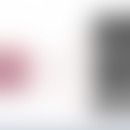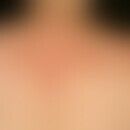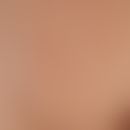Synonym(s)
DefinitionThis section has been translated automatically.
Benign, cutaneous (about 50%) or subcutaneous (about 50%), solitary, firm nodular neoplasm in children and young adults in the head-neck-torso region, the diagnosis of which generally proves to be histologically incidental.
EtiopathogenesisThis section has been translated automatically.
The histogenesis has not been clarified with final certainty (fibroblastic/myofibroblastic?). A neurogenic origin seems less likely (no relation to the "myxoid neurothekeoma", which would be better described as a nerve sheath myxoma) than a connective tissue one, so that the tumor is probably to be classified as an architectural variant of a dermatofibroma.
You might also be interested in
ManifestationThis section has been translated automatically.
Average age is 25 years in larger collectives (84% <40 years). Occasionally also in infants. m:w=1:1.8
LocalizationThis section has been translated automatically.
Head and neck area; torso.
Clinical featuresThis section has been translated automatically.
Unspectacular, 0.5 to 6.0 cm in diameter (diameter: 1.1 cm), painless, rarely painful, dome shaped raised, firm, red to red-brown lump. Most neurothekeomas are classified clinically as dermatofibromas.
HistologyThis section has been translated automatically.
- Multilobular or fascicular, usually blurredly limited, tumor node in the reticular dermis; 50% of the tumors are located subcutaneously, 33% infiltrate the fatty tissue and 8% the adjacent muscles. The epidermis above the tumor area is acanthotic. An epitheloid or polygonal cell type is predominant with abundantly developed eosinophilic cytoplasm, round nuclei with low chromatin content and clearly protruding nucleoli. Mitoses are present. Myxoid structures are found in about 30%, a predominant myxoid structure (see myxoid neurothekeoma) in 8%.
- Immunohistology: S100 negative (DD: myxoid neurothekeoma!); detection of alpha-smooth muscular actin expressing myofibroblasts, CD57 pos. (neural and neuroendocrine cells) and FXIIIa pos. (dermal dendritic cells) cells. Vimentin and Melan-A are not expressed.
Differential diagnosisThis section has been translated automatically.
Nerve sheath tumours (e.g. Schwannoma); epitheloid cell histiocytoma; melanoma, malignant, amelanotic.
LiteratureThis section has been translated automatically.
- Bhatia S et al (2003) Atypical cellular neurothekeoma. Dermatol Surgery 29: 1154-1157
- Cecchi A et al (2000) Cellular neurothekeoma on the left auricle. J Eur Acad Dermatol Venereol 14: 314-315
- Chatelain D et al (2000) Cellular neurothekeoma, a rare cutaneous tumor. Anatomo-clinical and immunohistochemical study of 2 cases. Ann Pathol 20: 225-227
- Filling DR et al (2003) Antibody to S100a6 protein is a sensitive immunohistochemical marker for neurothekeoma. J Cutan Pathol 30: 118-122
- Lefebvre DR et al (2014) Cellular neurothekeoma of the eyelid: a unique internal palpebral presentation. Ophthal Plast Reconstr Surg 30:e91-92.
- Livasy CA, Woosley JT (2003) Solitary nasal ala nodule in a young woman. Cellular neurothekeoma. Arch Dermatol 139: 531-536
- Papadopoulos EJ et al (2003) Neurotheoma: Report of a case in an infant and review of the literature. J Am Acad Dermatol 50: 129-134
- Watanabe K et al (2001) Subcutaneous cellular neurothekeoma: a pseudosarcomatous tumour. Br J Dermatol 144: 1273-1274
Disclaimer
Please ask your physician for a reliable diagnosis. This website is only meant as a reference.






